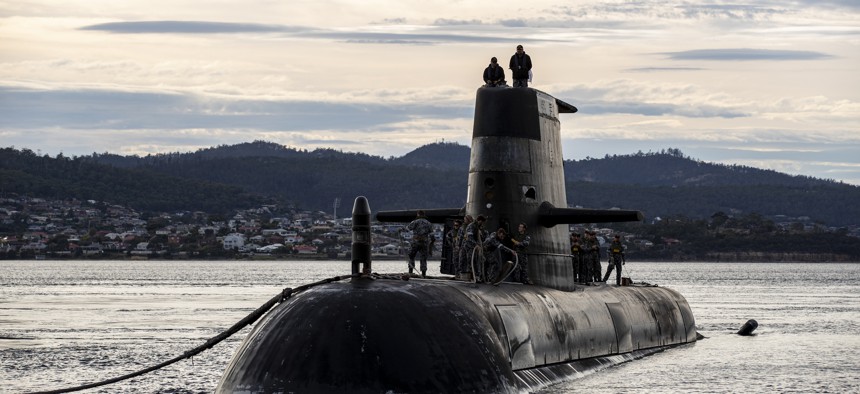
One of the submarines to be replaced with the nuclear submarine fleet agreed upon as part of AUKUS. LSIS Leo Baumgartner/Australian Defence Force via Getty Images
Lawmakers Highlight ‘Urgency’ To Train Aussie Submariners As AUKUS Celebrates One Year
“Whether you’re developing a workforce to build it or those to operate it, the sooner we begin that training pipeline, the better off we will be,” Rep. Donald Norcross said.
One year into a new security relationship between Australia, the United States, and the United Kingdom, lawmakers and naval experts are urging officials to begin training Aussie submariners so crews can be ready as soon as boats get in the water.
Discussions about how to actually supply Australia with nuclear submarines are still ongoing. More than 10 working groups are “right now taking a look at different aspects of the whole ecosystem that has to be in place in order to sustain, operate, maintain and produce submarines,” Chief of Naval Operations Adm. Mike Gilday told Defense One on Thursday, adding that the Navy will send recommendations to the Biden administration next March.
But even without an agreement to either share submarines with Australia or build them there, it’s important to start training the officers who will operate the boats as soon as possible, said Rep. Donald Norcross, D-N.J.
“We are talking about building the most sophisticated machine on Earth,” Norcross said. “Whether you’re developing a workforce to build it or those to operate it, the sooner we begin that training pipeline, the better off we will be.”
“The AUKUS partnership will play a critical role in deterring [Chinese Communist Party] aggression and protecting the Free World’s interests in the Indo-Pacific. But in order to maximize the partnership’s full potential, we need to ensure our Australian mates are both trained and equipped to handle the highest levels of U.S. Navy technology,” Rep. Mike Gallagher, R-Wisc., said in a statement. “This will not happen overnight, and we need to act with urgency to ensure this partnership can reach the next level.”
Last September, Australia, the United States, and the United Kingdom announced a new trilateral security agreement, under which Australia will get its first nuclear-powered submarines in addition to other technology sharing agreements. That kicked off an “18-month consultation period” for the three nations to figure out the best way to share subs with Australia.
The House fiscal 2023 National Defense Authorization Act includes a provision to establish a joint training pipeline for Australian submariners. Under the bill, at least two Australian sailors would train each year beginning in 2023 at the Navy’s Nuclear Propulsion School, complete the Submarine Officer Basic Course, and be assigned to an American submarine at sea. The section is based on a standalone bill introduced in June by members of the Congressional AUKUS Working Group.
The language to set up a training program is not included in the Senate’s version of the bill, which the chamber has not yet passed. Staff have not begun the conference process to work out a compromise between the two bills, so it’s unclear if it will make it into the final bill, a congressional staffer said.
Depending on what route the U.S. takes to get submarines to Australia, a delay in training sailors could be the thing that stalls the whole program, said Bryan Clark, a senior fellow at the Hudson Institute.
“The training is essential, because if you don’t have that, that’s going to end up being the long pole in the tent in terms of standing up nuclear submarines in Australia,” Clark said. “Getting the crew is going to be the long lead item.”
The United Kingdom already announced last month that Australian naval officers will begin training on British submarines.
Norcross emphasized that discussions are ongoing to get submarines to Australia, and that adversaries in the Indopacific know “there is no gap in the relationships” strengthened by AUKUS. But others said the administration should do more to publicly show its support for the new alliance.
“Australia is very excited and very forward leaning,” a second Congressional staffer said. “The U.S. has to reciprocate.”
Clark said “a lot of progress” has been made over the past year and that the government has narrowed it down to a few options to get nuclear submarines to Australia. The most likely path forward, he predicted, is to give Australia a Virginia-class submarine made in the United States, though he said the United States could also send a Los Angeles-class submarine to Australia after it completes a refueling overhaul. What’s unlikely is that Australia will begin building its own nuclear-powered submarines, at least in the short term.
“As we get to the anniversary, we’re finding the option space for getting an indigenously built sub is squeezing down,” Clark said. “One path is to start supplying some existing Virginia subs to Australia with combined crews, build the maintenance infrastructure there, and work towards building those subs in Australia.”
Clark was also quick to push back against any criticism that sending a new Virginia-class submarine to Australia would hurt America’s naval readiness, even if it would reduce the number of ships entering the fleet.
“Australia helps pay for something the U.S. wants in the Pacific anyways, and we get to base it in Australia,” he said. “This is a win-win.”
Bradley Peniston contributed to this report.





